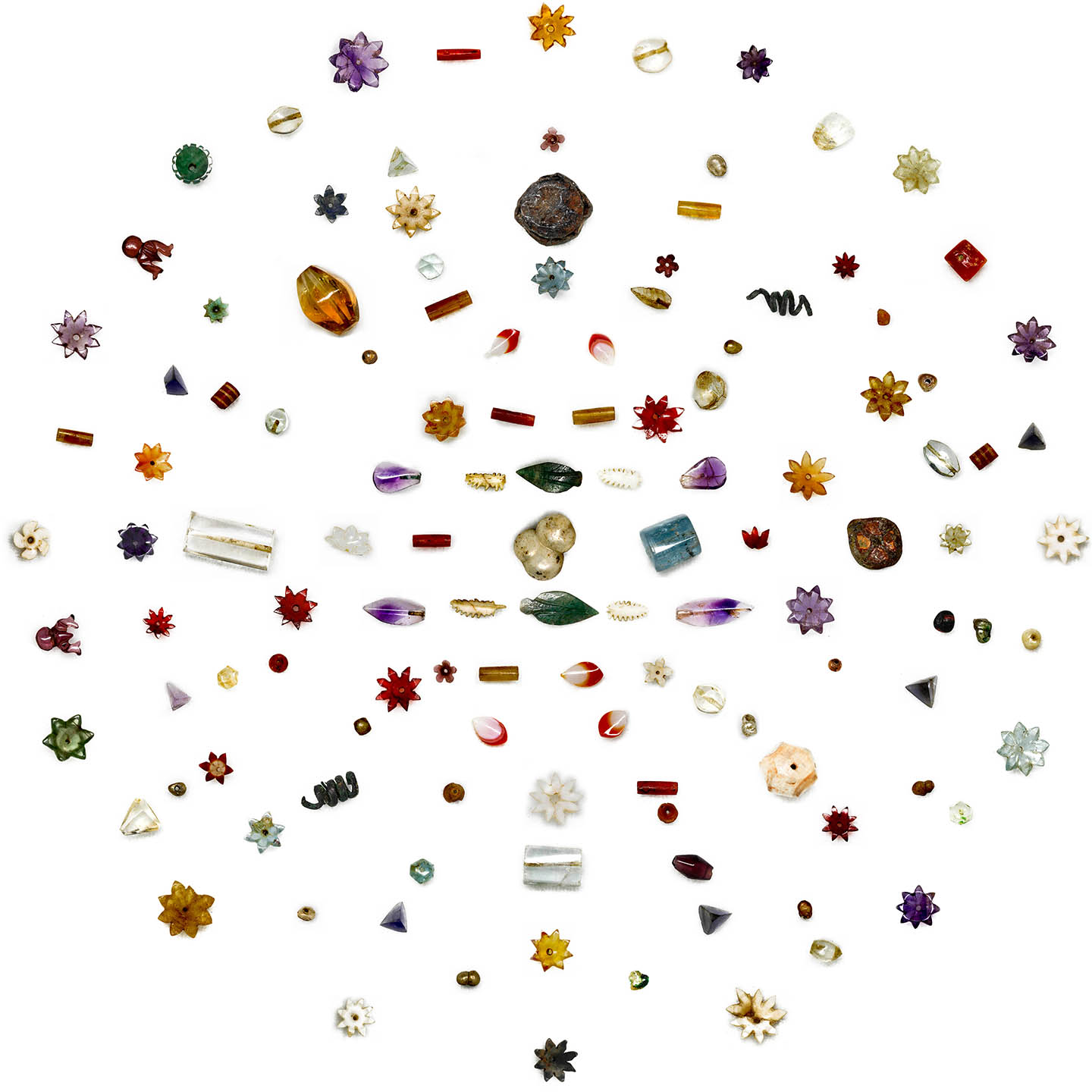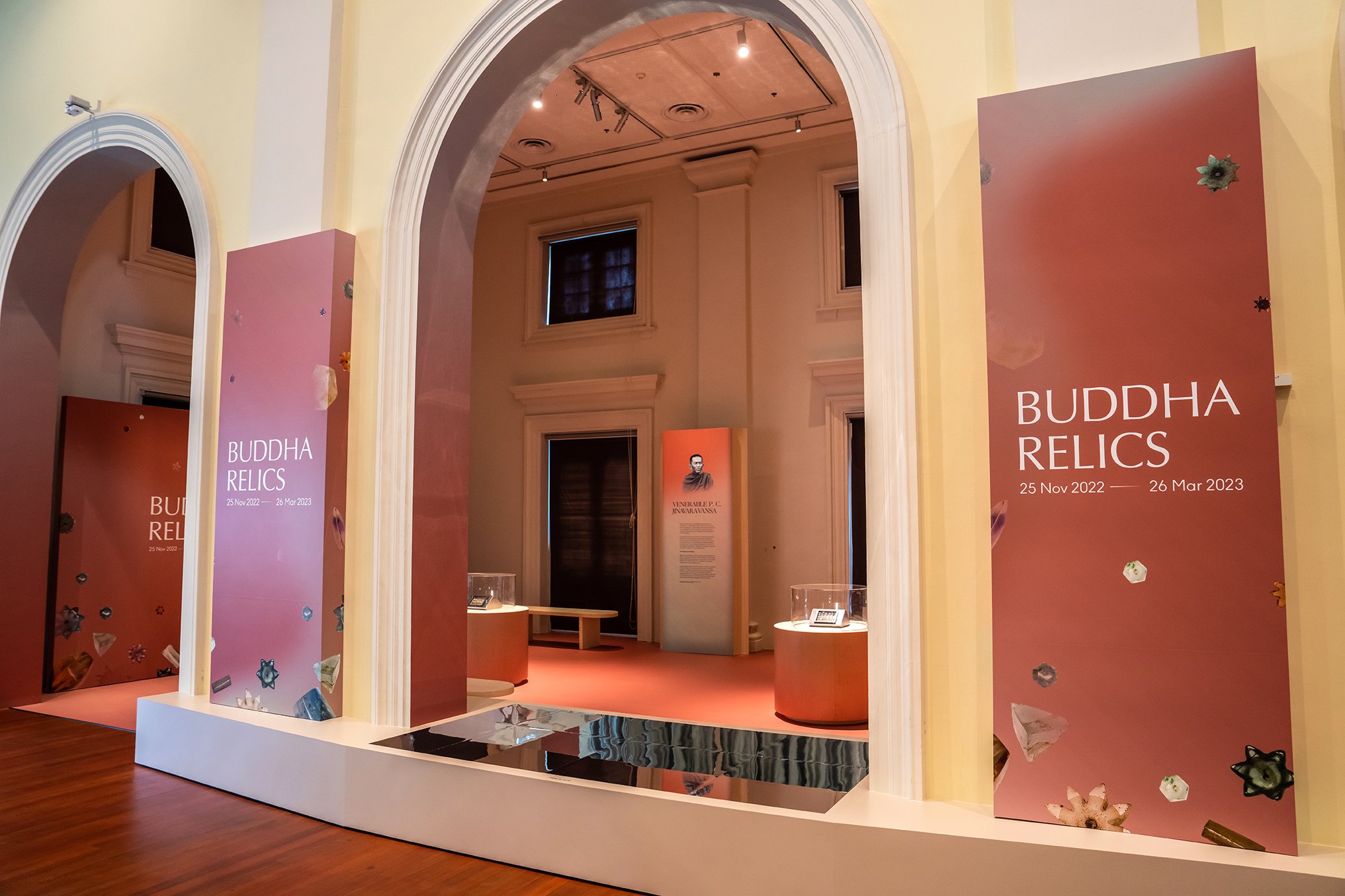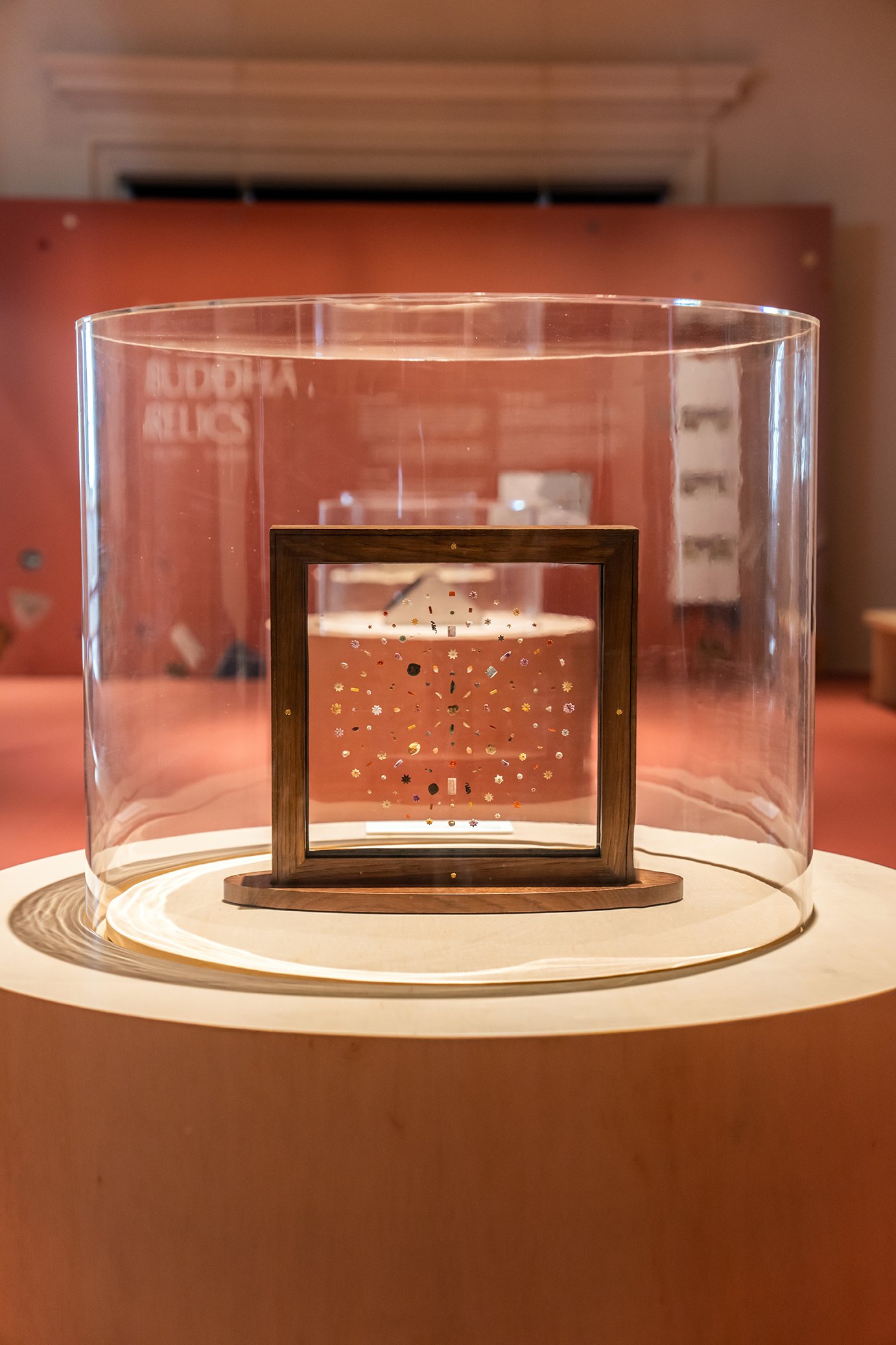Timeline since 1898
1898 In August, the stone coffer, the five reliquary vases and the majority of the jewels were given to the Indian Museum in Kolkata, where they remain to this day. W. C. Peppé is allowed to retain a number of duplicates from the excavation. These have remained within the Peppé family since 1898.
Newspapers including The Minneapolis Journal, The Philadelphia Inquirer, The Baltimore Sun and The New York Tribune run stories on the discovery.
1899 The relics from the Piprahwa stupa are handed over to representatives of King Rama V of Thailand Gorakhpur. They are then taken with great ceremony to Bangkok where they are once again divided: two portions are given to the Buddhist community of Myanmar and three portions to Buddhists of Sri Lanka. The remainder of the relics are enshrined in the Golden Mount pagoda in Bangkok.
1900 W.C. Peppé retires from his position as Manager of the Birdpur Estates. He returns to England with the jewels where he has them mounted in three cases.
T.W. Rhys Davids gives an illustrated lecture on the Piprahwa find at the Royal Asiatic Society. W.C. Peppé answers questions.
1920 W. C. Peppé returns to India and once again assumes responsibility for the running of the estates after the death of the previous manager F. H. Warren.
1926 W.C. Peppé returns to England leaving E. Mackenzie as manager and his son, Humphrey, as assistant manager. Humphrey becomes manager when Mackenzie retires in 1931.
1937 W.C. Peppé dies. Humphrey takes the jewels back out to India for exhibition purposes. They are shown to pilgrims and visiting VIPs touring Lumbini and other Buddhist sites.
1947 The Indian Independence Act was passed in the British Parliament. Proposals for Land Reform are introduced including the abolition of the Zamindari system ultimately resulting in the nationalisation of all estates including Birdpur.
1951-52 The Zamindari system was finally abolished in Uttar Pradesh. Humphrey Peppé hands over the family estates to the government but stays on at Birpdpur to receive compensation from the government. The Archaeological Survey of India takes ownership of Piprahwa.
The Dalai Lama & Panchen Lama stay at Birdpur and view the jewels.
1960 In January, the Dalai Lama, now in exile following the Tibetan uprising against the Chinese, visits Birdpur for a second time. Humphrey Peppé brings the Piprahwa jewels back to England. One of the cases returns broken.
1971 - 73 A team from the Archaeological Survey of India led by K.M. Srivastava resumed excavations at the site of Piprahwa. Srivastava digs beneath what Peppé would have considered to be ground level and discovers further reliquary vases containing fragments of charred bone. These relics from the original internment of the Buddha’s remains are on display at the National Museum in Delhi.
Srivastava concluded that the stupa was built in three phases. The first stage of development would have been undertaken by the Sakyas shortly after the Buddha’s death around 480 BCE. It most likely adhered to the Buddha’s instruction that he buried under earth ‘heaped up as rice is heaped in an alms bowl.’ The Buddha also instructed that the stupa of his internment be sited beside a crossroads so that passersby might pause to pay their respects and by their veneration gain in understanding and merit.
Peppé unearthed the second stage which was most likely constructed in the third century BCE after Ashoka’s opening of the stupas. This second phase was characterised by well-fired mud bricks made with rice and straw and laid in concentric circles. The base measured 116ft in diameter and 22ft in height.
During the third stage of construction, the height of the stupa was raised, and the base squared off. Monastic buildings were also constructed around the stupa. This all happened at an unknown date, although most likely during the Kushan era, approximately two hundred and fifty years after the reign of Ashoka.
Srivastava continued his excavation of the surrounding area. Here he discovered terracotta sealings and a pot with the legend Kapilavastu suggesting Piprahwa was at least the site of the monastery serving Kapilavastu if not Kapilavastu itself.
2002 Historian Charles Allen’s book ‘The Buddha and the Sahibs’ provides a detailed account of the excavation of Buddhist historical sites by British civil servants during their time in India. He includes an account of the discovery at Piprahwa. His book coincides with the release of an online conspiracy theory that a government archaeologist who was excavating across the border in Nepal, Dr. A.A. Führer, may have tampered with the Piprahwa find.
2004 Charles Allen views the collection with Paul Seto of the Buddhist Society in London and a journalist from the Sunday Times. Vicki Mackenzie’s article ‘Bones of the Buddha’ revives interest in the Piprahwa discovery. A BBC documentary is discussed.
2006 Bricks used to build the stupa were made of rice straw. A grain of rice taken from one of them during the excavation is carbon dated to a range of 60-160AD, a date consistent with the final phase of the building of the stupa in the Kushan era following Ashoka.
Charles Allen invites leading academics and the conspiracy theorist who suggested Führer’s involvement to a conference at Harewood House to discuss the Piprahwa find. There are only two speakers at the conference who challenge the find’s authenticity.
Letters kept by W. C. Peppé documenting key aspects of the find are brought to light for the first time. Their contents render the conspiracy untenable.
2008 Historian Charles Allen publishes a detailed account of the Piprahwa discovery, its historical and religious significance and the discussions that followed. 'The Buddha and Dr Führer: An archaeological scandal' details the revelation that a government archaeologist, Dr. A. A. Führer, was guilty of plagiarism and forgery. It concludes that, as Führer arrived at Piprahwa six weeks after the discovery was made, he could in no way have contaminated it. Furthermore, correspondence between the British Civil Service and Prince Prisdang, a former Thai ambassador turned Buddhist monk, reveals that the donation of the relics to the King of Thailand were a direct result of Prisdang’s petitioning.
The letters kept by W. C. Peppé are donated to the Royal Asiatic Society and made available to the public at its Reading Room in London.
2013 The proposed BBC documentary resurfaces as 'Bones of the Buddha' and airs on the National Geographic Channel on May 11th. It adopts the dramatic conceit of W. C. Peppé as a man unjustly doubted because of Dr A.A. Fuhrer’s proximity to Piprahwa but finally vindicated. It also provides a detailed argument that Emperor Ashoka removed the Buddha’s remains from their original burial sites before interring them in newly built stupas as related in the Asokavadana. World-renowned epigraphist Harry Falk studies the inscription on the reliquary urn and declares it to be authentic.
2016 Gemologist Dr Jack Ogden closely examines the gems and notes that what appear to be single-bore drill holes - thus more fitting to a later time period - are on closer inspection the result of drilling from each side and therefore more likely to be from an earlier period. Comparisons to other finds date the gems to an era consistent with the reign of Ashoka.
Research by Cranfield University concludes there is no glass in the original collection. Specific dating therefore will be hard to achieve.
2018 Dr. Jack Ogden conducts further and more extensive examinations. In his paper 'Report on the beads and related objects from the Piprahwa Stupa', he concludes that the range of gem materials and the high-quality lapidary work suggests a date between 300BC and 100BC.
In 2018, Reflectance Transformation Images (RTI) were taken of the objects in the case of gold and silver offerings. These objects were selected for imaging because some of them possess iconography. Dr Charles Crowther and his PhD student, Taylor Bennett, at the Centre for the Study of Ancient Documents, the University of Oxford, kindly agreed to capture and process the RTI images so they could be made available to the public.
The resulting PTM file is available here for downloading. To view the file, you will also need to download the free RTIViewer software from Cultural Heritage Imaging here.
One of the gold discs With LION & Swastika
2018 Harry Falk’s paper ‘The Ashes of the Buddha’ is published in Bulletin of the Asia Institute. It offers the most detailed insight into the internment of the Buddha’s relics and the relic offerings at Piprahwa since Charles Allen’s book ten years prior.
From December 13th 2018 - March 31st 2019 the jewels are loaned to The Museum Rietberg in Zurich as part of an exhibition called ‘Next Stop Nirvana - Approaches to Buddhism’. The exhibition explores the life of Prince Siddharta Gautama and sheds light on the ways in which people throughout the ages have painted a picture of the Buddha’s life. Press for the exhibition was enthusiastic; Il Giornale notes that ‘ A group of gemstones is probably the most extraordinary loan’. While Deutsche Wells referred to the Piprahwa Collection as ‘the biggest sensation of the exhibition.’
2019 The gemstones are displayed as part of the ‘Power of Objects; Charged With Buddha’s Blessings’ exhibition at the Rubin Museum of Art in New York from June 2019 for one year.
The Jewels on Display at the Rubin Museum of Art, New York
2020 The Covid-19 crisis wreaks havoc on museum schedules everywhere. The exhibition that was planned by the Metropolitan Museum of Art for a November opening is postponed. The Rubin extends its exhibition of the gems until May 2021.
Conservator, Dana Norris, works on a new third case to house the loose gems that are currently displayed without a frame. Visitors will be able to see more of the jewels’ excellent craftsmanship at the Singapore exhibition in 2022.
2022 From November 2022 - March 2023 the jewels are displayed at the Asian Civilisations Museum in Singapore. The Buddha Relics display is a special showcase complementing the main exhibition Body & Spirit. The Human Body In Thought & Practice.
Images courtesy of Asian CIvilisations Museum, Singapore
2023 From July 21st - November 13th the jewels feature as part of the Tree & Serpent Exhibition at the Metropolitan Museum of Art, New York. Curated by John Guy, the Florence & Herbert Irving Curator of South and Southeast Asian Art at the Met, the exhibition explores the story of the origins of Buddhist Art.
photos by anna-Marie Kellen, courtesy of the Metropolitan Museum of Art, New York’
Prior to the exhibition’s opening, John Guy pens an article titled ‘Buddha and the Jewel-filled Casket’ for Orientations bi-monthly magazine. In the article, he states that previous excavations at Piprahwa provide compelling evidence that the site ‘was the location of the ancient capital city of the Shakya clan, Kapilavastu.’ John Guy further concludes that ‘the Piprahwa bone relics represent the Shakya clan’s share of the original division by the Brahmin Drona, as implicit in the reliquary inscription.’
2023 From December 22nd - April 14th 2024 the collection of gem relics from the Piprahwa discovery can be seen at the National Museum of Korea. The display is part of the larger Tree & Serpent exhibition which was previously at the Metropolitan Museum of New York.
Photograph by Park han sol courtesy of the Korean Times
Describing the jewels as ‘sarira’ the Korean Times suggests that it was through these precious relics that Buddhism made its entry into southern India during the mid-third century BCE. This historical event transpired when King Ashoka reinterred and redistributed the sacred remains of the Buddha.
2025 From 6th-23rd February the collection of gem relics are on display in the new exhibition space at Sotheby’s Maison, situated within the Landmark complex in central in Hong Kong.












